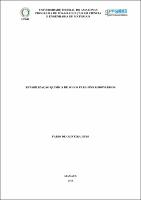| ???jsp.display-item.social.title??? |


|
Please use this identifier to cite or link to this item:
https://tede.ufam.edu.br/handle/tede/6927| ???metadata.dc.type???: | Dissertação |
| Title: | Estabilização química de solos para fins rodoviários |
| ???metadata.dc.creator???: | Huss, Fábio de Oliveira  |
| ???metadata.dc.contributor.advisor1???: | Frota, Consuelo Alves da |
| ???metadata.dc.contributor.referee1???: | Paula, Marcos Marques da Silva |
| ???metadata.dc.contributor.referee2???: | Pinheiro, Ana Maria Guerra Seráfico |
| ???metadata.dc.description.resumo???: | A construção de subcamadas de pavimentos com a predominância de materiais granulares é o que recomenda as normas da construção rodoviária. Entretanto, a escassez de agregados pétreos em algumas regiões, caso de Manaus (AM), torna seu uso inviável do ponto de vista econômico. Portanto, tem-se a necessidade da busca de novos materiais que possam substitui-los nessa espécie de estrutura. Para resolver esse tipo de problema, a Engenharia Civil utiliza, em especial na construção dos pavimentos, a denominada estabilização de solos. No presente trabalho, pesquisou-se a estabilização química de um solo argiloso proveniente do Ramal do Puraquequara, localizado entre Manaus e Rio Preto da Eva, com a participação individual dos aditivos químicos ECOLOPAVI®, EMC²® e TERRAZYME®, bem como da geogrelha MacGrid® NET. Caracterizaram-se o material natural e as composições de acordo com testes físicos, químicos, mineralógicos e mecânicos, para os tempos de cura de 3 (três), 7 (sete) e 28 (vinte e oito dias). Os resultados mostraram o material natural como um solo argiloso e classificado como A-4 e CL. A caracterização mineralógica, por meio da Fluorescência e Difração de Raio-X, identificou o solo natural com alto teor de óxido de alumínio (36,5%) e dióxido de silício (57,2 %). Por meio do DRX, foi possível também constatar a presença da caulinita e do quartzo. Em conformidade com os resultados da Resistência à Tração por Compressão Diametral, a composição, tendo a presença do ECOLOPAVI®, apontou os melhores valores relativos ao solo “in natura” e às demais formulações. Conforme os dados oriundos da Resistência à Compressão Simples, as composições com a participação dos aditivos ECOLOPAVI® e TERRAZYME® obtiveram os melhores resultados. No tocante ao ensaio da RCS, utilizando-se a geogrelha MacGrid® NET e o produto ECOLOPAVI®, observou-se o aumento considerável desse parâmetro para o tempo de cura de 3 (três) dias. |
| Abstract: | The construction of sub-layers of pavements with the predominance of granular materials is what recommends the norms of road construction. However, the scarcity of stone aggregates in some regions, in the case of Manaus (AM), makes their use unfeasible from the economic point of view. Therefore, there is a need to search for new materials that can replace the stone aggregates in this kind of structure. In order to solve this type of problem, Civil Engineering uses, in particular in the construction of pavements, the so-called soil stabilization. In the present work chemical stabilization of a clay soil from the Puraquequara branch, located between Manaus and Rio Preto da Eva, is studied with the individual participation of the chemical additives ECOLOPAVI®, EMC²® and TERRAZYME®, as well as the MacGrid geogrid ® NET. Natural material and compositions were characterized according to physical, chemical, mineralogical and mechanical tests for cure times of 3 (three), 7 (seven) and 28 (twenty-eight days). The results showed the natural material as a clay soil, classified as A-4 and CL. The mineralogical characterization, through Fluorescence and X-Ray Diffraction, identified the natural soil with high content of aluminum oxide (36.5%) and silicon dioxide (57.2%). By means of the XRD, it was also possible to verify the presence of kaolinite and quartz. In accordance with the results of Tensile Strength by Diametral Compression, the composition, with the presence of ECOLOPAVI®, indicated the best values relative to the natural soil and other formulations. According to data from Unconfined Compression Testing, the compositions with the participation of the additives ECOLOPAVI® and TERRAZYME® obtained the best results. Regarding the UCT, using the MacGrid® NET geogrid and the ECOLOPAVI® product, a considerable increase of this parameter was observed for the cure time of 3 (three) days. |
| Keywords: | Solo argiloso Estabilização química Resistência à tração por compressão diametral Resistência à compressão simples Geogrelha MacGrid® NET ECOLOPAVI® EMC²® TERRAZYME® |
| ???metadata.dc.subject.cnpq???: | ENGENHARIAS: ENGENHARIA DE MATERIAIS E METALÚRGICA |
| Language: | por |
| ???metadata.dc.publisher.country???: | Brasil |
| Publisher: | Universidade Federal do Amazonas |
| ???metadata.dc.publisher.initials???: | UFAM |
| ???metadata.dc.publisher.department???: | Faculdade de Tecnologia |
| ???metadata.dc.publisher.program???: | Programa de Pós-graduação em Ciência e Engenharia de Materiais |
| Citation: | HUSS, Fábio de Oliveira. Estabilização química de solos para fins rodoviários. 2018. 75 f. Dissertação (Mestrado em Ciência e Engenharia de Materiais) - Faculdade de Tecnologia, Universidade Federal do Amazonas, Manaus, 2018. |
| ???metadata.dc.rights???: | Acesso Aberto |
| URI: | https://tede.ufam.edu.br/handle/tede/6927 |
| Issue Date: | 13-Dec-2018 |
| Appears in Collections: | Mestrado em Ciência e Engenharia de Materiais |
Files in This Item:
| File | Description | Size | Format | |
|---|---|---|---|---|
| Dissertação_FábioHuss_PPGCEM.pdf | Dissertação Final - Fábio Huss | 2.52 MB | Adobe PDF |  Download/Open Preview |
Items in DSpace are protected by copyright, with all rights reserved, unless otherwise indicated.




